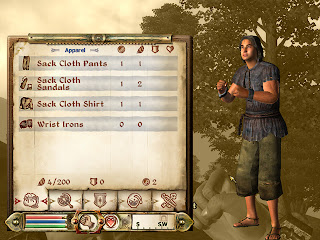The first Elder Scrolls game was called Arena, released in 1994, it was originally supposed to be a fantasy Gladatorial combat game with traveling teams, and sidequests between the arena matches. In development, however, the RPG elements took over, the engine moved into a First Person perspective, and the Arena combats seemed more and more 'tacked on' until they were dropped altogether. The game was late to publication, full of bugs and critically panned, but the world established there gave it a cult following, and enough of a fanbase to support a sequel.
Daggerfall (TES II) embraced the few things that worked about Arena, and was a game massive in scope and ambition. The continent the game is set in was twice the size of Great Britain, with over 15,000 towns and settlements and 750,000 NPCs to interact with. Players could explore many, many different dungeons, own property, become a vampire or werewolf if infected by those creatures, and the story had six endings so different that reconciling them for another sequel required Divine Intervention. Complaints about the breadth of the game at the expense of depth, as most of the nearly half a million square kilometers of space was randomly or procedurally generated by the computer, so none of the locations or characters not in major quest locations had very much to them.
The third Elder Scrolls RPG, Morrowind, was released to nervous anticipation by fans of the series. It was so much smaller than Daggerfall, did that mean it was dumbed-down, or a step backward? Upon release, fans weren't disappointed. The sandbox, open-exploration concepts in earlier games were present, but they were enhanced by packing the terrain in with carefully thought-out features. Instead of hundreds of miles of randomly-generated terrain with a few static landmarks, ten square miles (26 km) of well-developed dungeons, settlements and other locations with planned monsters and characters worth interacting with. Factions and guilds to quest for and advance in as well as a main story that was in many ways even better than Arena's or Daggerfall's made Morrowind really something special. Due to Bethesda's release of a development kit to the modding community, this game is still being played today, nearly ten years after release.
Oblivion was about twice the size of Morrowind, featured a complete overhaul of the graphics engine, and refined the option to zoom out from first-person to play in a third-person perspective, though the animations were a little clunky and awkward in this mode, though they were improved from the same feat in Morrowind. The fourth game continued to refine some of the elements that made the first three games in the series great, and allowed dungeons randomly littered throughout the world to scale up as characters became more powerful. Monsters would get stronger, dropped loot would get better. The freedom to explore any area you could see, steal any item, kill any NPC (though some would make the game's main quest unfinishable) and customize spells and weapons improved. One downside to Oblivion, however, were the hellish portals that needed to be closed to complete the main quest. Inside each was a depressingly similar generic “hellish” dungeon to trudge through and hit the magic “self-destruct” button at the end.
 |
| Typically cutting-edge visuals for the time in each game usually means that a new Elder Scrolls game is time for a new computer. |
Each of the Elder Scrolls Games since Daggerfall has worked on being more “epic” in scale and ambitiousness of content, with thousands of pages of text forming the many, many books that can be found in each world, rounding out the lore and history of the setting. The worlds are getting bigger as new games appear in the series, but deeper at the same time, so we won't be seeing more miles of empty fields like we had in Daggerfall, but instead an ever-increasing and continually interesting game world. Expanding on this promise to keep getting bigger and better at the same time, we have the newest game in the series, Skyrim.
The focus on the return of dragons to the world of the Elder Scrolls is a powerful one, with a lot of the early demos shown at E3 putting the great wyrms, and specific fights against them on display. The powerful “dragon shout” abilities garnered from defeating the winged titans give characters abilities themed on draconian powers including fire-breathing. The third-person engine and animations have been greatly improved, making that perspective a more attractive choice for play, and the complete redesign of all user interface, menus, inventory and character options is aimed at accessibility. Having seen the gorgeous graphics and read about the planned scope of the world, and some of the great moments in preview videos like a dragon suddenly swooping down and snatching up a humanoid opponent fighting the character, and dropping his mangled body some distance away... I'm excited for it.
There are a few parts of the announcement that give me pause, however. Skyrim is being developed specifically as a console game for the Xbox360 and PS3, and they'll work backward from that for a PC port. “PC port of a console game” is a phrase that gives many PC gamers the jibblies, and for good reason. All the talk of streamlining and accessibility is a great idea, until you realize that games in the past that have attempted to do this did so at the expense of depth and have greatly disappointed their fans in the process. (I'm looking at YOU, Mass Effect 2 and Dragon Age 2.) I'm going to remain optimistic, as I remember the panic when the size of the world for Morrowind was revealed to Daggerfall fans, and how unfounded that turned out to be.


No comments:
Post a Comment